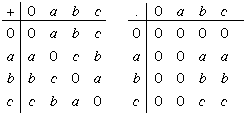Rings and Fields
Definition and examples
Looking at the common features of the examples discussed in the last section suggests:
Definition
A ring is a set R together with a pair of binary operations + and . satisfying the axioms:
- R is an abelian group under the operation + ,
- The operation . is associative (and it is of course closed also),
- The operations satisfy the Distributive Laws:
For ∀ a, b, c ∈ R we have (a + b).c = (a.c + b.c) and a.(b + c) = a.b + a.c .
Remarks
- The additive identity is called the zero of the ring and is written 0.
Note that 0.a = a.0 = 0 for all a ∈ R (See Exercises 1 Qu 1)
- Sometimes the ring has a multiplicative identity. If it does, we call it a Ring with identity and write the multiplicative identity as 1.
- Even if the ring has an identity, it may not be possible to find multiplicative inverses. In particular (if |R| > 1) the element 0 will never have an inverse.
- The operation . is not necessarily commutative. If it is, we call R a commutative ring.
Examples
- The integers Z with the usual addition and multiplication is a commutative ring with identity. The only elements with (multiplicative) inverses are ±1.
- The integers modulo n: Zn form a commutative ring with identity under addition and multiplication modulo n. This is a finite ring {0, 1, ... , n - 1} and the elements a which are coprime to n are the ones which are invertible.
- The sets Q, R, C are all commutative rings with identity under the appropriate addition and multiplication. In these every non-zero element has an inverse.
- The quaternions H = {a + ib + jc + kd | a, b, c, d ∈ R} mentioned in the last section form a non-commutative ring with identity under the appropriate addition and a multiplication which satisfies the rules:
- i2 = j2 = k2 = i j k = -1.
- In fact one can find an inverse for any non-zero quaternion using the trick:
- (a + ib + jc + kd)(a - ib - jc - kd) = a2 + b2 + c2 + d2
- as in the similar method for finding the inverse of a complex number.
- The set of all 2 × 2 real matrices forms a ring under the usual matrix addition and multiplication.
This is a non-commutative ring with identity  .
.
In fact, the set of n × n matrices with entries in any ring forms a ring.
- Just as we can specify a finite group by giving its multiplication table, we can specify a finite ring by giving addition and multiplication tables.
For example, R = {0, a, b, c} with tables 
Then it is true (but almost impossible to check) that these do satisfy the ring axioms.
In fact these are the addition and multiplication tables of

where arithmetic is done modulo 2.
- Polynomials
As indicated in the last section these are some of the most important examples of rings.
Definition
Let R be a commutative ring with an identity. Then a polynomial with coefficients in R in an indeterminate x is something of the form
- a0 + a1x + a2x2 + ... + anxn where ai ∈ R.
- One adds and multiplies polynomials "in the usual way".
The ring of such polynomials is denoted by R[x].
Remarks
- Note that each non-zero polynomial has a finite degree: the largest n for which an ≠ 0.
- The indeterminate x is not a member of R. Neither are x2, x3, ... They are simply "markers" to remind us how to add and multiply.
One could (and maybe should) define a polynomial to be a sequence (a0 , a1 , a2 , ... ) in which only finitely many of the terms are non-zero.
Exercise: Write down how to add and multiply two such sequences.
- Two polynomials are equal if and only if all of their coefficients are equal.
JOC/EFR 2004
 .
.
